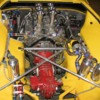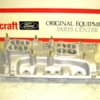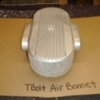quote:
e
Well the main advantage to the 2x4 is the progressive way the carbs work. The linkage is from the Ford 427 2x4 setup which goes back with Ford to 1963 and is proven itself time and time again.
The carbs are mounted backwards with the primary carb in the front. This gives an extra 1/2" spacing to the distributor/fuel bowl and locates the primary throttle close to the center of the intake.
The linkage allows running on just those that primary part (front two barrels) of the primary carb until about 3,500 rpm when it starts to open the front barrels of the secondary carb.
The secondaries are vacuum actuated and open as the engine load permits, so the all considered, the engine runs around town on a 300cfm two barrel (in effect) until 3,500 rpm.
The main jets are also 59's. This is an indication of a better fuel distribution in the intake vs. at least a 67 on a single 4v cab (if not more).
Remember, you are talking to a "Weber" guy here so I feel that I have the picture on the pluses and minuses here.
Driveability wise,the Webers have no chance in competing with this Holley set up and because you can run a wild cam with them, and you can't with the Webers, there is a huge advantage power wise.
Ford once rated the difference between the single 4v and the 2x4v as 50hp, all things given equal. That doesn't even begin to explain it. The driveability of the setup is unreal.
Also consider that I also have a 67 Shelby GT500 (#3074 for those of you who are checking up on me) and it runs a 428 with a pair of 715 Holleys (3300 & 3301). Stock that set up takes a pair of 652 because of the station wagon 428 cam it cam with. Don't ask me about the cam in mine. Already too many parameters going on here.
The problem with the set up is relatively simple. You need to get your fuel levels in the bowls right or else they make a mess leaking through the throttle shafts and spilling into the intake manifold. In short, you set the levels lower so they don't trickle out of the view plug holes. But again, that's another story.
I will point out that the top of the hill, the Ford GT40 Mark IV (427 TP) in '67 ran this setup.
When you look at the set up in that car you will see a remarkable similarity to the layout of the Pantera with a similar set up.
The Holleys are by no means a piece of cake to get going but they are about 4 times easier then the Webers to do and don't change with the weather like the Webers.
Is 1200cfm of carbs too much? First off if you are usin 37mm chokes in the Webers, that's 2,400cfm right there.
Second these A3 heads flow 330cfm @ 28in-mg. How many cfm is that? (330 x 8)
No. 1,200is pretty nice if you ask me, but I'll admit I am certifiable. Don't let "them" know that I know this. "They" have been trying to tell me for years to get help? I already did, and this is what sanity really is.






